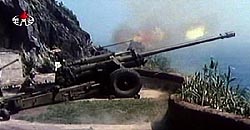South’s radar failed last week when North fired

A military source said that radar installed to detect hostile fire did not work last week when North Korea fired five shots toward the Northern Limit Line, the disputed maritime border, on Aug. 10.
“We must confirm the location of the source of the firing through the ARTHUR and HALO systems, but ARTHUR failed to operate, resulting in a failure to determine the source of the fire,” said the source.
Barely filling in for ARTHUR, which stands for Artillery Hunting Radar, were two HALO devices that pointed out where the shells had landed. The official did not explain why ARTHUR failed but mentioned there had been 78 reports of mechanical failure for the radar system from November 2009 to November 2010.
The HALO (hostile artillery location) systems, which are acoustic detection devices, were installed on Yeonpyeong and Baengnyeong Islands in July to reinforce defenses against North Korea. ARTHUR was also introduced on the islands shortly after the Yeonpyeong shelling to determine the source of future attacks.
The military said after last week’s artillery fire that it had been difficult to determine the shells’ source because of “very heavy” fog. At the time, the Joint Chiefs of Staff stated that the artillery fire had probably come from the North’s Yongmae Island.
Since Yeonpyeong, South Korea’s military has said it would strike back immediately in the case of another North Korean provocation. But last week’s faulty equipment and failure to get accurate intelligence have cast doubts on the military.
The military since last year had been monitoring a seawall under construction near Yongmae Island, convinced it was a new naval base that was being built. But recent intelligence has pointed out it was part of a reclamation project in the region.
By Jeong Yong-soo [christine.kim@joongang.co.kr]
한글 관련 기사 [중앙일보]
북 NLL 해안포 쏠 때, 군 대포병 레이더 ‘먹통’
기계 낡아 전원 장치 고장
“북 포격 땐 2~3배 응사할 것”
북한이 지난 9일 서해 북방한계선(NLL) 이남의 우리 해상으로 해안포를 사격했을 당시 백령도에 배치된 대포병 레이더(AN/TPQ-36)가 작동하지 않았던 것으로 확인됐다.
24일 군과 국회 국방위원회 관계자들에 따르면 북한의 해안포 사격 당시 해병 6여단에 배치된 대포병 레이더의 안테나를 움직이는 전원장치가 고장 나 작동되지 않았다. 그동안 이곳의 대포병 레이더는 노후화로 인해 고장이 잦았으며, 포탄의 탐지 능력에도 제한이 있다는 지적을 받아왔다.
김태영 국방부 장관은 이날 국회 국방위에 출석, “(기존의 AN/TPQ-36) 대포병 레이더는 해상에서 제한점이 있다”며 “(탐지거리가 긴) AN/TPQ-37이 해병에게 적합하다면 해병에 제공할 것”이라고 말했다. AN/TPQ-37은 50㎞ 밖에서 날아오는 포탄 및 로켓탄을 탐지할 수 있지만 대당 가격이 AN/TPQ-36의 4배인 147억원이다.
김 장관은 또 “북한이 NLL에서 포 사격을 가하면 어떻게 대응하겠느냐”는 김장수(한나라당) 의원의 질문에 대해 “지상에서 하는 것과 동일하게 2~3배의 조치를 하는 방식으로 대응할 것”이라고 밝혔다. 김 장관은 “적(북한군)이 NLL 이남 (남측) 해상으로 포를 쏘면 비례성 원칙에 따라 적이 도발한 거리만큼 (북한의) 빈 바다에 쏠 것”이라며 “북한군의 포격으로 우리 측이 피해를 당한다면 자위권 차원에서 즉각 응징사격을 할 것”이라고 설명했다.










with the Korea JoongAng Daily
To write comments, please log in to one of the accounts.
Standards Board Policy (0/250자)